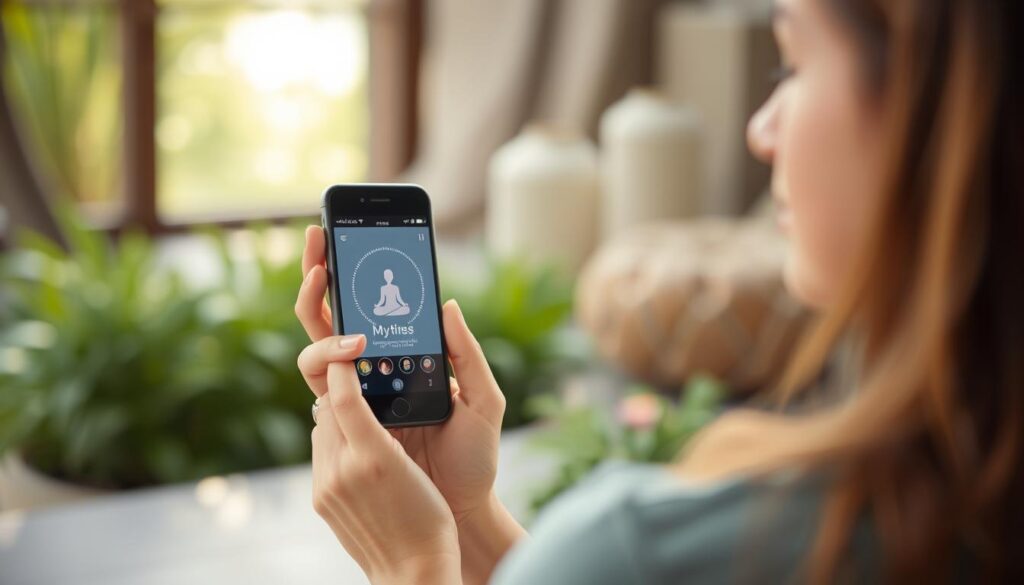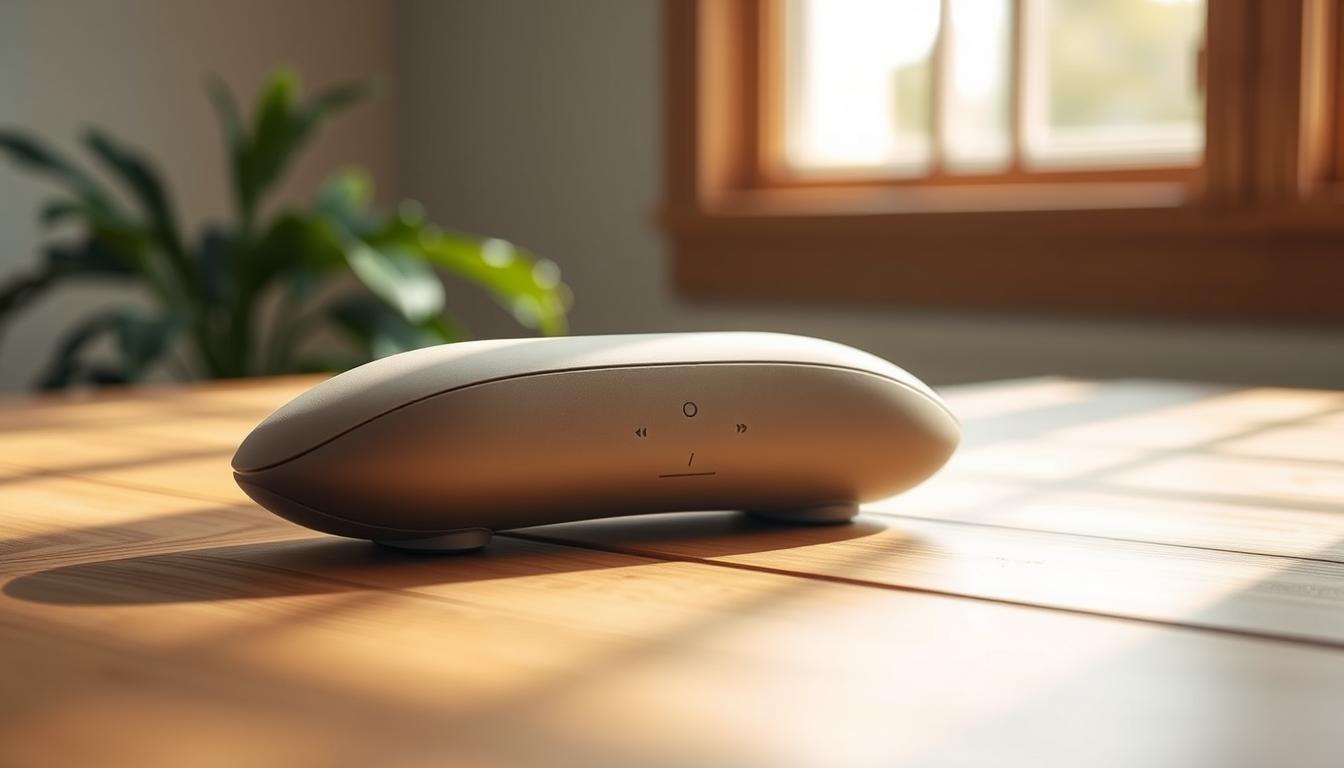I still remember the first time I used meditation audio to calm my mind – it was a game-changer. As a busy professional, I was constantly battling stress and anxiety. I found that incorporating mindfulness practice through audio-guided meditation helped me develop a consistent practice, bringing more clarity and relaxation into my life.
As I started practicing meditation, I realized that it is not about achieving a specific state but about being present in the moment, paying attention to my thoughts and body. Regular practice has helped me strengthen the connection between my body and mind, making me more aware of my overall well-being.
Through this article, I will share with you the benefits of using meditation audio, including improved focus, reduced stress, and enhanced self-awareness. I will also provide an overview of the top guided exercises for achieving mental clarity and relaxation.
Key Takeaways
- Discover the benefits of using meditation audio for mental clarity and relaxation
- Understand how mindfulness practice can be made more accessible through audio guidance
- Learn how to develop a consistent meditation practice using guided audio
- Find out how meditation can improve focus, reduce stress, and enhance self-awareness
- Get an overview of the top guided exercises for mental clarity and relaxation
The Power of Audio-Guided Meditation
Guided meditation audio has become an essential tool in my own mindfulness journey, and it can be for you too. As a former Buddhist monk with over 15 years of experience in mindfulness practices, I’ve seen firsthand how audio guidance can enhance the meditation experience. By providing a supportive structure, audio-guided meditation helps maintain attention and fosters a deeper state of mindfulness.
How Audio Enhances the Meditation Experience
Audio guidance in meditation creates a comforting anchor for wandering thoughts, allowing practitioners to gently bring their focus back to the present moment. The human voice in guided meditations provides reassurance, making it easier to stay on track. By listening to guided instructions, beginners can develop mindfulness skills more quickly than with self-guided practice alone. This is because the audio cues help regulate the pace and rhythm of the meditation, promoting a state of relaxation and awareness.
Science Behind Guided Meditation Effectiveness
Research has shown that guided meditation can positively impact brain activity, leading to reduced stress and increased attention. The concept of “entrainment” explains how our brains naturally synchronize with the rhythm and pace of guided instructions, promoting a state of calm and presence. By leveraging this phenomenon, audio-guided meditation can bridge the gap between intellectual understanding of mindfulness and the actual experience of being present.
Furthermore, guided meditation can create a sense of connection with a teacher, reducing feelings of isolation that some people experience during solo practice. Different voice qualities and instruction styles can also enhance various aspects of the meditation experience, catering to individual preferences and needs.
Benefits of Regular Meditation Practice
The benefits of regular meditation practice are multifaceted, ranging from improved mental health to enhanced physical wellbeing. By incorporating meditation into your daily routine, you can experience these benefits firsthand.
Mental Health Improvements
Regular meditation practice has been shown to reduce anxiety and depression, while also improving emotional regulation. This is achieved by training the mind to stay present, reducing the tendency to ruminate on stressful thoughts. As a result, individuals can better manage their mental health and develop a more positive outlook on life.
Physical Health Benefits
Meditation has been linked to various physical health benefits, including lower blood pressure and enhanced immune function. By reducing stress and promoting relaxation, meditation can have a positive impact on overall physical wellbeing. This, in turn, can lead to a healthier and more balanced life.
Enhanced Productivity and Focus
Improved focus and attention are additional benefits of regular meditation practice. By training the mind to stay present, individuals can experience real-world productivity gains in their work and daily life. This is particularly beneficial for busy professionals looking to optimize their performance.
| Benefits | Mental Health | Physical Health | Productivity |
|---|---|---|---|
| Meditation Practice | Reduced anxiety and depression | Lower blood pressure | Improved focus |
| Mindfulness | Improved emotional regulation | Enhanced immune function | Increased productivity |
Essential Guided Exercises for Beginners
For those new to meditation, getting started can be as simple as dedicating a few minutes a day to guided exercises.
Here are some simple yet powerful exercises to get you started.

Breathing Meditation (5-10 Minutes)
Start with simple breathing meditation techniques that can be practiced for just 5-10 minutes. This exercise involves focusing on your breath, observing its pattern, and bringing your attention back to it whenever your mind wanders.
Body Scan for Newcomers
The body scan is a gentle exercise that helps develop body awareness and presence. Lie down or sit comfortably, and bring your attention to different parts of your body, starting from your toes and moving up to your head.
Simple Mindfulness Practices
Incorporate mindfulness into your daily activities like walking, eating, or washing dishes. Pay attention to the sensations, sights, and sounds around you, and stay present in the moment.
These exercises will help you develop the attention muscles needed for more advanced meditation practices, and establish a consistent practice.
Meditation Audio for Stress Reduction

Meditation audio offers a powerful tool for reducing stress and promoting relaxation. By leveraging guided meditation practices, individuals can better manage stress and cultivate a sense of calm.
Quick Relief Practices
For immediate stress relief, quick 3-5 minute guided meditation practices can be incredibly effective. These short sessions focus on breath work and can be used during busy workdays or stressful situations, helping to bring attention back to the present moment.
Deep Relaxation Sessions
Longer deep relaxation sessions work to release accumulated tension in both body and mind. These sessions guide listeners through deep, slow breathing exercises, promoting a state of relaxation and reducing stress.
Working with Difficulties Meditation
The “Working with Difficulties” meditation approach helps transform our relationship with stressful thoughts and emotions. By cultivating mindfulness and awareness, individuals can better recognize stress patterns before they escalate, leading to a more peaceful experience in daily life.
Regular practice of these stress-reduction meditation practices creates lasting resilience, not just temporary relief. By incorporating mindfulness meditation into daily routines, individuals can develop a more mindful approach to managing stress and improving overall well-being.
Sleep-Enhancing Meditation Recordings
Many of us struggle with sleep, but meditation recordings can be a valuable tool in helping us relax and fall asleep.

There are several types of meditation recordings that can help improve our sleep.
Body Scan for Better Sleep
A body scan meditation is a powerful technique that helps release physical tension, making it easier to fall asleep.
By focusing on different parts of our body, we can relax and let go of any tension or stress that might be keeping us awake.
Breathing Techniques for Insomnia
Certain breathing techniques can help calm our nervous system, making it easier to fall asleep.
By slowing down our heart rate and relaxing our body, we can create a state of relaxation that is conducive to sleep.
Calming Visualizations for Sleep
Calming visualizations
can also help us relax and fall asleep by redirecting our attention away from stressful thoughts.
By imagining a peaceful environment or scenario, we can create a mental state that is conducive to sleep.
Regular use of these meditation recordings can help establish healthier sleep patterns over time.
Mindfulness Meditation Audio Collections

In the realm of mindfulness, audio collections play a crucial role in guiding individuals toward a more present and aware state. These collections typically encompass a variety of meditation practices designed to cultivate mindfulness.
Breath, Sound, and Body Awareness
One of the foundational practices in mindfulness meditation involves integrating awareness of breath, environmental sounds, and body sensations. Techniques like “Breath, Sound, Body Meditation” (12 mins) and “Body and Sound Meditation” (3 mins) help develop core mindfulness skills – the ability to observe experiences with curiosity and without judgment.
Present Moment Awareness Practices
Present moment awareness practices are essential in training attention to recognize when the mind wanders and gently return to the present. These practices enhance the ability to stay focused and aware, contributing to a more mindful daily life.
Mindful Movement Audio Guides
Mindful movement audio guides bring meditation into physical activities such as walking, gentle stretching, or yoga. These guides help in developing a well-rounded mindfulness practice that can be applied in various life situations, making mindfulness more accessible and practical.
Mindfulness meditation audio collections cater to different learning styles and preferences, offering both shorter and longer versions of practices. This flexibility allows individuals to choose practices that fit their schedule and personal resonance, whether it’s with body awareness, sound, or breath. By systematically building skills, these collections help in developing a comprehensive mindfulness practice.
Loving-Kindness and Compassion Meditations

By incorporating loving-kindness meditation into our daily routine, we can foster a deeper sense of compassion and connection. This practice is particularly powerful for developing genuine goodwill toward ourselves and others.
Self-Compassion Practices
Self-compassion is about cultivating a kinder relationship with ourselves. Through loving-kindness meditation, we can counteract our inner critic and develop a more nurturing awareness of our thoughts and feelings.
Extending Kindness to Others
As we progress in our practice, we gradually expand our circle of care from loved ones to neutral people and even to those with whom we have difficult relationships. This mindfulness practice enhances our capacity for empathy and understanding towards others.
Healing Relationships Through Meditation
Loving-kindness meditation can be especially healing during times of conflict or when working through relationship difficulties. By cultivating warmth and care, we can transform how we interact with others and navigate challenging situations, leading to more harmonious experiences in our personal and professional lives.
The practice of loving-kindness meditation complements more attention-focused mindfulness techniques by adding a heart-centered dimension. Research has shown that this type of meditation activates brain regions associated with positive emotions and empathy, enriching our overall meditation practice.
Productivity-Boosting Guided Exercises
By incorporating mindfulness meditation into your daily routine, you can achieve more in less time. Meditation isn’t just about relaxation; it’s also a powerful tool for enhancing productivity. I’ll share how specialized guided exercises can help you stay focused, energized, and creative throughout the day.
Focus Enhancement Meditations
These meditations are designed to improve concentration and reduce mind-wandering during work or study. By practicing mindfulness meditation, you can enhance your ability to stay on task and achieve your goals. Regular practice can lead to improved attention and reduced distractions.
Energy-Boosting Practices
Combat mental fatigue and afternoon slumps without relying on caffeine or other stimulants. Energy-boosting practices can help you stay energized and motivated. These practices can be particularly helpful during midday when energy levels tend to dip.
Creativity Stimulation Techniques
Access flow states and innovative thinking through guided visualization. These techniques can help you tap into your creative potential and approach problems from new angles. By incorporating creativity stimulation techniques into your daily routine, you can enhance your problem-solving skills.
| Guided Exercise | Benefit | Best Time to Use |
|---|---|---|
| Focus Enhancement Meditations | Improved concentration | Morning |
| Energy-Boosting Practices | Increased energy | Midday |
| Creativity Stimulation Techniques | Enhanced creativity | When innovation is needed |

By incorporating these productivity-boosting guided exercises into your daily routine, you can create healthier work patterns and achieve more in less time. Regular mindfulness practice can lead to improved task switching and reduced cognitive cost of distractions.
Top Meditation Apps and Platforms
Navigating the landscape of meditation apps and platforms can be daunting, but I’m here to guide you through the top options. With so many choices available, it’s essential to find the one that best suits your mindfulness needs and preferences.

Free Meditation Resources
For those new to meditation or on a tight budget, there are excellent free resources available. The UCLA Mindful App is a great starting point, offering guided meditations led by Diana Winston, the Director of Mindfulness Education at UCLA’s Mindful Awareness Research Center. You can download the app on iTunes or Google Play and access a variety of mindfulness meditation practices.
Subscription-Based Services
For those who prefer a more structured approach or additional content, subscription-based services like Headspace, Calm, and Insight Timer are worth considering. These platforms offer a wide range of guided meditation sessions, from body scan meditations to loving-kindness exercises, tailored to different needs and experience levels.
Specialized Meditation Programs
Some meditation apps and platforms specialize in specific areas, such as sleep, anxiety, or workplace performance. These specialized programs can be particularly beneficial if you’re looking to address a particular challenge or goal. When choosing a platform, consider the qualifications of the meditation teachers and the quality of the content to ensure it aligns with your needs and enhances your meditation experience.
Creating Your Own Meditation Audio Library
Building a customized meditation audio library is a simple yet effective way to enhance your mindfulness practice. As you explore various meditation resources, you’ll find that having a well-organized library can make a significant difference in your daily practice.
Organizing by Purpose and Duration
When creating your meditation audio library, it’s essential to organize your content by purpose and duration. For instance, you can categorize your meditations into groups such as stress relief, sleep enhancement, or focus improvement. You can also organize them by duration, such as 5, 10, or 20-minute meditations. This organization system will help you quickly find the right meditation for your needs at any given time.
- Stress relief: 5-minute breathing exercises, 10-minute body scan meditations
- Sleep enhancement: 20-minute calming meditations, 10-minute relaxation exercises
- Focus improvement: 5-minute focus-enhancing meditations, 20-minute mindful practice sessions
By doing so, you’ll create a flexible collection that you can easily use in various situations throughout your life.

Personalizing Your Practice
Personalizing your meditation practice is crucial to maintaining consistency and making it a part of your daily routine. Identify the meditation styles and teachers that resonate with you the most, and make sure to include those in your library. For example, if you find that you prefer body scan meditations or guided meditation sessions, include more of those in your library.
As you continue to practice, you can refine your library by evaluating which meditations are most effective for you and keeping those as your core resources. This will help you maintain a consistent practice and make it easier to stay on track, even when faced with a busy life.
Integrating Meditation Audio into Daily Life
Making meditation a part of our daily routine can have a significant impact on our well-being. By incorporating meditation audio, we can bring a sense of calm and presence into our daily life. I have found that using guided meditation in the morning sets a positive tone for the entire day.
Starting the Day with Guided Meditation
Starting the day with guided meditation can be a powerful way to set intentions and cultivate mindfulness. For example, a simple 5-minute guided meditation can help us focus our attention and prepare for the day ahead. This practice can be as simple as focusing on our breath or setting an intention for the day.
Midday Reset Practices
During the middle of the day, we can use midday reset practices to recharge and refocus. Short meditation exercises can help us regain our composure and tackle tasks with renewed energy. For instance, a 2-minute mindfulness meditation can be a quick and effective practice to reduce stress.
Evening Wind-Down Sessions
In the evening, we can use meditation audio to create a boundary between work and rest. By practicing mindfulness meditation, we can signal to our body and mind that it’s time to relax. For example, a guided body scan can help us relax and prepare for a restful night’s sleep.
Let’s take a look at how we can integrate meditation into our daily lives:
| Time of Day | Meditation Practice | Benefits |
|---|---|---|
| Morning | Guided meditation | Sets intentions, cultivates mindfulness |
| Midday | Short meditation exercises | Recharge, refocus |
| Evening | Guided body scan | Relaxation, prepare for sleep |
Conclusion: Transforming Your Mind Through Audio Meditation
Through our journey into the world of meditation audio, we’ve seen how it can be a powerful ally in achieving mental clarity and relaxation.
As we cultivate mindfulness through guided meditation, we gradually transform our relationship with our thoughts, emotions, and experiences. It’s not about achieving perfection but about being present in the moment, gently returning to it whenever our mind wanders.
As we bring meditation into our daily lives, we can create a ripple effect of compassion and understanding, starting from within ourselves and extending to others. By showing up for our regular practice, we can experience a deeper sense of connection, warmth, and care for ourselves and those around us.
I encourage you to explore different styles of guided meditation and find what resonates with you. Start with just one audio practice that calls to you, and let it be a stepping stone to a more mindful, more compassionate you. As we practice mindfulness meditation together, we can create a more mindful and compassionate world, one breath at a time.
FAQ
What is meditation audio, and how can it help me?
Meditation audio refers to recordings that guide you through meditation practices, helping you cultivate mindfulness, relaxation, and inner peace. By listening to these recordings, you can reduce stress, improve your focus, and enhance your overall well-being.
How do I get started with meditation audio?
To get started, explore various meditation audio resources, such as apps, websites, or online platforms. You can begin with short sessions, like 5-10 minute breathing meditations or body scans, and gradually move to longer practices as you become more comfortable with the technique.
Can meditation audio help with sleep issues?
Yes, certain meditation audio recordings, such as sleep-enhancing meditation recordings, can help you relax and prepare your mind and body for a restful sleep. Techniques like breathing techniques for insomnia and calming visualizations can be particularly helpful.
How can I incorporate meditation audio into my daily routine?
You can integrate meditation audio into your daily life by listening to morning routines with guided meditation, taking a midday reset with a short meditation session, or unwinding in the evening with a calming practice. This can help you stay focused, reduce stress, and improve your overall quality of life.
Are there meditation audio resources suitable for beginners?
Absolutely! Many meditation audio resources cater to beginners, offering simple mindfulness practices, breathing meditations, and body scan for newcomers. These gentle introductions can help you establish a consistent practice and build your confidence in meditation.
Can I create my own meditation audio library?
Yes, you can curate your own meditation audio library by selecting recordings that resonate with you and organizing them by purpose and duration. This allows you to personalize your practice and easily access the meditations that suit your needs.
